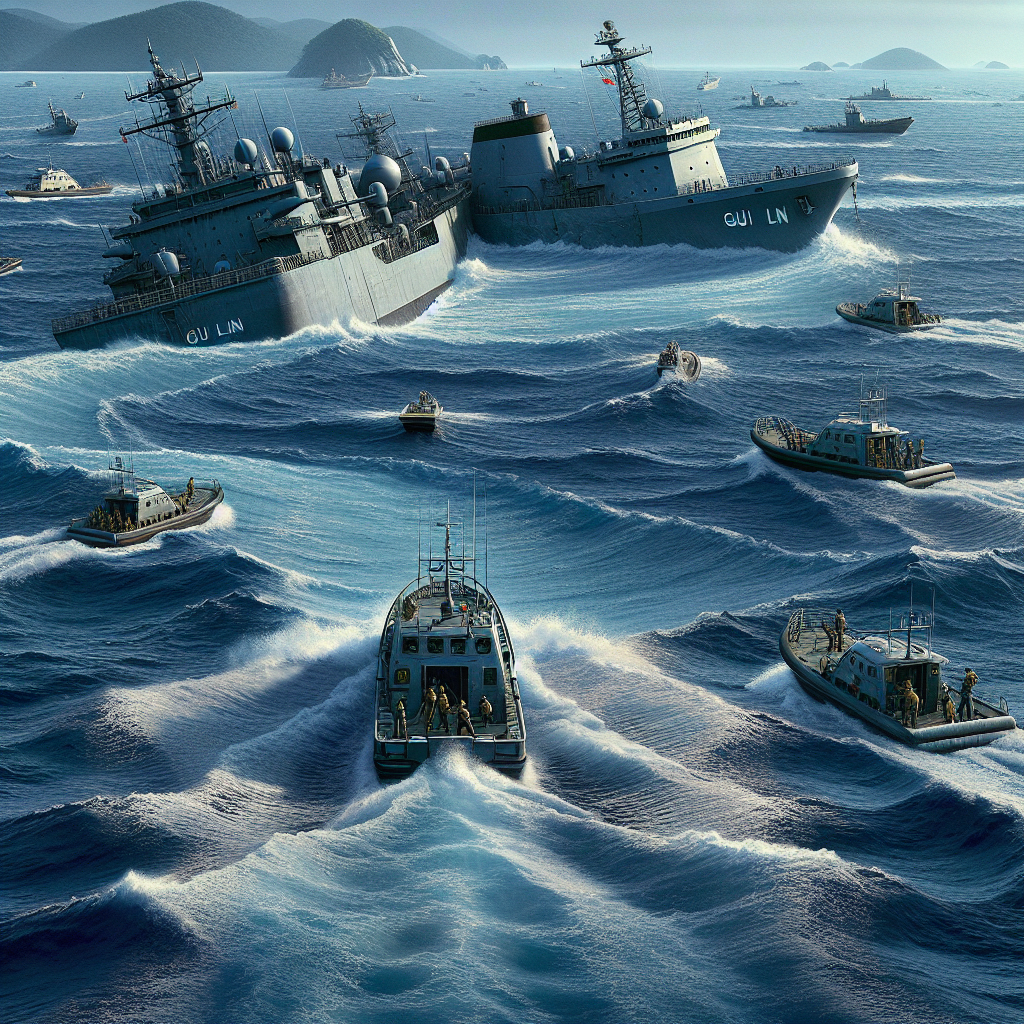In recent days, a Chinese Coast Guard ship collided with the Chinese Navy destroyer “Gui Lin” in the waters near Huangyan Island in the South China Sea. Despite the Philippines publicly releasing a video of the scene and demanding compensation from China, the Chinese Ministry of National Defense did not admit to the collision involving their own ship, instead shifting the blame to the Philippines. This attempt to dodge responsibility in the official response, coupled with strict information control by domestic media, has raised widespread doubts about the Chinese Communist Party’s cover-up of the truth.
On August 11, a maritime incident of significance unfolded in the waters near Huangyan Island (also known as Scarborough Shoal) in the South China Sea. According to a video released by the Philippine Coast Guard, a Chinese Coast Guard ship (CCG 3104) collided with the Chinese Navy destroyer “Gui Lin” while attempting to intercept a Philippine patrol boat, resulting in severe deformation and loss of navigational capability to the Coast Guard ship.
It’s worth noting that the collision was not caused by the Philippine vessel, but rather was an accidental occurrence during the high-speed interception maneuver by the Chinese ships.
The Philippines stated that their vessel was delivering supplies to local fishermen at the time of the incident, while the Chinese Coast Guard ship engaged in interception tactics such as water cannon attacks and dangerous approaches.
The Philippine Foreign Minister issued a statement on August 15, clearly stating that “the collision was not caused by our side,” and demanded that China take responsibility for any losses resulting from similar incidents.
During a press conference on August 15, Chinese Ministry of National Defense spokesperson Jiang Bin did not directly admit or deny the collision involving their ship, but instead shifted focus by accusing the Philippine vessel of “illegally intruding” into the waters of Huangyan Island, emphasizing that the Chinese Coast Guard was “lawfully dispersing.”
Jiang Bin specifically mentioned that the Philippine Coast Guard ship engaged in “dangerous actions such as high-speed charging, large-angle turns crossing ahead of the Chinese ship’s bow,” while avoiding the specific details of the collision.
This response strategy by China has been interpreted by outsiders as a typical crisis public relations tactic, attempting to maintain narrative control by diverting attention but revealing a logical inconsistency when dealing with their own mistakes.
Simultaneously, Chinese official media and social platforms have implemented strict information control measures regarding this incident. Previous official statements from the Chinese Coast Guard only confirmed the “dispersal” of the Philippine fleet, completely omitting any mention of the collision involving their own ship.
On major social media platforms like Weibo and Douyin, searching for keywords such as “Huangyan Island collision” yields limited relevant content, with only official posts promoting “successful dispersal” remaining visible.
It was observed that a comment by Hu Xijin, former editor-in-chief of the Global Times, defending the Chinese actions in the collision was deleted from Weibo hours later, reflecting the routine censorship mechanisms of the Chinese cyberspace administration.
On Social Platform X, overseas Chinese users widely shared the incident video and criticized the Chinese behavior, yet such content is inaccessible within China. Mainland Chinese media outlets like Observer Network only vaguely mentioned the “dispelling of the Philippines vessel,” deliberately avoiding specifics of the collision incident.
Analysts suggest that China’s stringent information control measures in this case are not solely driven by traditional notions of “national security” but rather by concerns of public questioning the “invincible myth” of the military apparatus. Particularly in the current sensitive political climate, such “negative events” might be seen as political vulnerabilities, potentially triggering internal accountability.
Shen Mingshi, a researcher at the Taiwan Institute for National Defense and Security Studies, noted the timing of the collision incident as significant, occurring during a crucial period of high-level meetings within the Chinese leadership, potentially yielding unpredictable political repercussions. He analyzed that the shift from previously mild tactics like water cannon dispersal to “dangerous interception” strategies by the Chinese Coast Guard could be influenced by leadership pressures, with some officials possibly attempting to impact the political landscape through manufactured conflicts.
The international community has responded strongly to this incident. Japan, Australia, and New Zealand all expressed shock at the dangerous maneuvers leading to the collision of the two vessels.
Japan’s Ambassador to the Philippines, Kawayasu Endo, stated, “Japan upholds the rule of law and opposes any actions that escalate tensions. We express concern about such actions repeatedly occurring in the South China Sea.” The Australian Embassy in Manila voiced concerns about “the dangerous and unprofessional behavior of Chinese ships near Huangyan Island involving the Philippine Coast Guard,” emphasizing the necessity to “cool down, exercise restraint, and abide by international law.”
The Philippines is a crucial ally of the United States in Asia. US Ambassador to the Philippines MaryKay Carlson condemned the latest actions targeting Philippine vessels by China in the waters near Huangyan Island as “reckless behavior,” following which the US Navy guided-missile destroyer USS Higgins and littoral combat ship USS Cincinnati operated in the vicinity of Huangyan Island.
This collision incident involving Chinese ships occurred against the backdrop of ongoing tensions in the South China Sea region. Maritime frictions between China and the Philippines are becoming increasingly frequent, with Huangyan Island being a strategic flashpoint and a longstanding area of dispute between the two countries.
In 2016, an international arbitration tribunal ruled in favor of the Philippines, deeming China’s “nine-dash line” claims in the South China Sea lacking sufficient legal basis. The tribunal also found that China’s land reclamation activities in the South China Sea resulted in “irreversible environmental damage.” However, China has consistently refused to accept that ruling.

